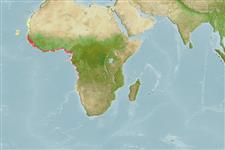Classification / Names
Common names from other countries
Main reference
Size / Weight / Age
Max length : 114 cm TL male/unsexed; (Ref. 40637); common length : 50.0 cm TL male/unsexed; (Ref. 3593); max. published weight: 12.0 kg (Ref. 40637)
Length at first maturity
Lm 35.0, range 28 - ? cm
Environment
Marine; demersal; depth range 0 - 70 m (Ref. 3593)
Climate / Range
Tropical, preferred 26°C (Ref. 107945); 27°N - 22°S
Distribution
Short description
Dorsal
spines
(total): 11;
Dorsal
soft rays
(total): 28-33;
Anal
spines: 2;
Anal
soft rays: 7. Diagnosis: large fish, elongate and compressed; eyes small; snout short; mouth large and oblique; lower jaw prominent; both jaws with bands of villiform teeth (upper jaw with teeth in outer row larger and sharper, including a pair of large median canines, lower jaw with teeth in inner row larger and sharper); 6 pores on chin and 5 marginal pores on snout; gill rakers long and slender, longer than gill filaments at angle of 1st gill arch; dorsal fin long and deeply notched; second anal fin spine rather short and slender, attaining about 2/3 of the length of 1st soft ray and comprised over 3 times in head length; caudal fin pointed; scales weakly ctenoid on body, cycloid on snout and suborbital region; lateral line extending to end of caudal fin; swim bladder carrot-shaped, its front end with a pair of appendices subdividing into an anterior group of short branches and 2 posterior groups of long, slender tubules, one of them ventral, the other dorso-lateral and longer, bordering the bladder throughout its length (Ref. 57396).
Coloration: silvery grey, with series of small dark spots following scale rows, oblique on anterior part of back and sides, horizontal posteriorly; black spot at tip of spinous part of dorsal fin; pelvics and anal fin more or less dark yellowish; caudal fin dark; inside of gill cover black (Ref. 57396).
IUCN Red List Status (Ref. 115185)
Threat to humans
Harmless
Human uses
Fisheries: minor commercial; gamefish: yes
More information
ReferencesAquacultureAquaculture profileStrainsGeneticsAllele frequenciesHeritabilityDiseasesProcessingMass conversion
Tools
Special reports
Download XML
Internet sources
Estimates of some properties based on models
Phylogenetic diversity index
PD50 = 0.5156 many relatives (e.g. carps) 0.5 - 2.0 few relatives (e.g. lungfishes)
Trophic Level
3.8 ±0.71 se; Based on food items.
Resilience
Medium, minimum population doubling time 1.4 - 4.4 years (K=0.33; tmax=8; assuming tm=2)
Vulnerability
Moderate vulnerability (42 of 100)
Price category
